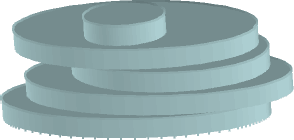当前你的浏览器版本过低,网站已在兼容模式下运行,兼容模式仅提供最小功能支持,网站样式可能显示不正常。
请尽快升级浏览器以体验网站在线编辑、在线运行等功能。
3200:Babel Towers
题目描述
Babel Inc. is a company that designs structures for skyscrapers. They have developed a simple technique to estimate the feasibility of a design, based on the fact that their designs are equivalent to stack blocks of circular section and constant height. The height of a block is used as the unit of lineal measure.
Blocks are all made of the same non deformable uniform material, so that the weight of a block is proportional to its volume and its center of mass is the geometrical center of the block. A typical block is of the form

which weight is determined by the radius of the circular section (because every one has height 1).
For n ≥ 1, an n-tower is a stack of n blocks. Blocks in an n-tower are numbered 0, 1, …, n − 1 , from the bottom to the top. Given an n-tower, its k-subtower is defined as the k-tower with the first k blocks of the n-tower, 0 ≤ k < n . An example of a 5-tower could look like the following figure:

A tower is feasible when it can be built putting its blocks one by one from bottom to top. At each building step the corresponding subtower should be stable, i.e., every block of it must remain in the position that it is designed to stay. When placing a block results in a stack of blocks which part of it has a center of mass that lies out of the base on that it is supported we say that the resulting tower collapses and is unfeasible.
Babel Inc. does not consider stable a situation where the center of mass of the system of blocks that are supposed to rest on a block lies on the border of the supporting surface. For instance, two blocks of the same dimensions with one of them placed centered on the circumference of the other constitute a 2-tower that collapses; but if the second one is placed within the circle of the first one the system is feasible.
Your problem is to help Babel Inc. in the evaluation of tower designs. Given a design for a n-tower you must judge if it is feasible and, if it is not, you must tell at which floor it would collapse. In this last case you give k as answer, with 0 < k < n, if the (k − 1)-subtower is feasible but the k-subtower collapses.
输入解释
The input file contains several test cases.
Each test case begins with a line indicating N, 0 < N < 1000, the number of blocks that the designed tower should have.
Then, there is a line describing each one of the blocks. The block k, 0 ≤ k < N, is described by a line containing 3 integers separated by blanks, of the form
xk yk rk
which indicates that the block k with radius rk must be placed supported on the block k − 1 (exception: block 0 is placed on the ground) with its center of mass on the point ‹xk, yk, k + 0.5› with respect to a grid with origin in ‹0, 0, 0› , for |xk|, |yk| ≤ 105 and rk ≤ 105.
输出解释
Output texts for each input case are presented in the same order that input is read.
For each test case the answer must be of the form ‘Feasible’ if the design is feasible. In other case, the answer should be of the form ‘Unfeasible k’ indicating that the (k − 1)-subtower is feasible but the k-subtower is unfeasible.
输入样例
3 0 0 10 2 0 12 -4 1 1 4 0 0 12 0 0 10 0 9 10 0 17 5 4 0 0 4 0 1 4 1 0 4 -1 -1 4 2 10 10 5 0 0 3 0
输出样例
Feasible Unfeasible 3 Feasible Unfeasible 1
最后修改于 2020-10-29T06:55:40+00:00 由爬虫自动更新
共提交 0 次
通过率 --%
| 时间上限 | 内存上限 |
| 1000 | 65536 |